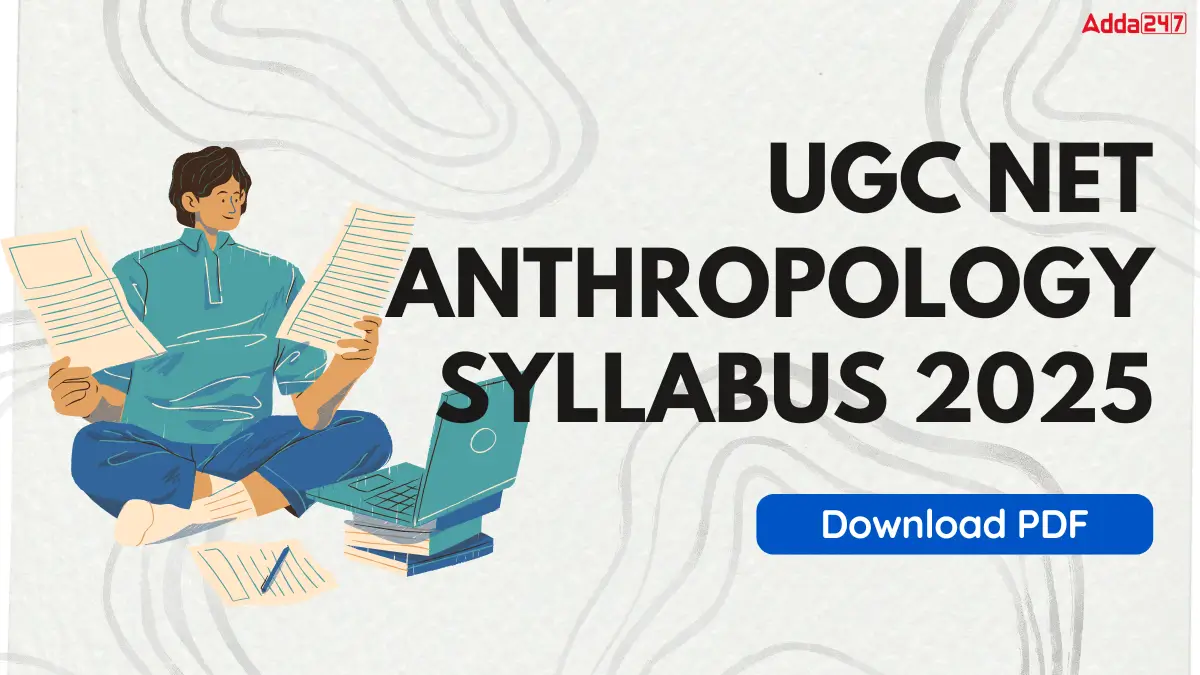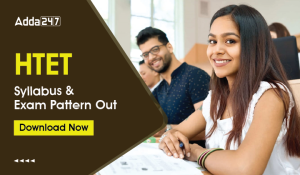Table of Contents
University Grants Commission will be conducting the UGC NET 2025 exam for the December cycle. The preparation for the exam begins with a detailed syllabus. Candidates who chose Anthropology as their primary syllabus for Paper II can find the UGC NET Anthropology Syllabus 2025 on the official NTA website. The syllabus provides a comprehensive understanding of the topics covered and aids in planning how to cover it effectively within the allocated timeframe. This article presents detailed information on the NET Anthropology Syllabus for the convenience of candidates.
UGC NET Anthropology Syllabus 2025
UGC NET Anthropology Syllabus has been available on the official website. Candidates must be thoroughly prepared for the extensive UGC NET in order to clear the UGC NET Exam. UGC NET Paper 1 lasts for one hour and carries a total score of 100 and UGC NET Anthropology Paper 2 has 200 marks questions and lasts two hours.
UGC Anthropology Exam Pattern
The UGC NET 2025 Entrance Exam will take place from 31 December 2025. Therefore, it is high time they get acquainted with the UGC NET Anthropology Exam Pattern. The UGC NET exam is divided into two papers, lasting for a total of three hours. The UGC NET exam includes questions of the objective type in a multiple-choice format.
Paper 1 is common for all applicants. Paper 2 is however subject-specific. The UGC NET Anthropology is massive, hence preparation for the exam must begin early. Several vital subtopics are also covered in the syllabus for smooth exam preparation. The UGC NET Anthropology Syllabus presented here will help you identify the important parts of each topic and create a concrete study schedule.
UGC NET Anthropology Syllabus for Paper II
The UGC NET Syllabus Paper II for Anthropology Subject will cover 10 units. This test will comprise 100 questions, each worth two marks. Every question is compulsory to attempt. Below are the units available for the UGC NET Anthropology Syllabus PDF for Paper II that candidates can review.
UGC Anthropology Unit 1: Fundamentals of Anthropology
- History, development, aim and scope of Anthropology, relationship with other sciences, different branches of Anthropology (including Linguistic Anthropology) and their interrelationship.
- Research methodology and methods: Concepts of epistemology, ontology and theoretical perspectives. Types of research (qualitative and quantitative), research design, hypothesis.
- Fieldwork and fieldwork tradition, Ethnography, Observation, Interview, Case Study, Life History, Focus group, PRA, RRA, Genealogical Method, Schedules and Questionnaires, Grounded Theory, Exploration and Excavation, GIS.
- Statistics: concept of variables, sampling, measures of central tendency and dispersion, parametric and nonparametric bivariate and multivariate (linear regression and logistic regression) statistical tests.
- Techniques of Analysis: Content analysis, Discourse analysis and Narratives.
UGC Anthropology Unit 2: Evolution
- Lamarckism, Neo-Lamarckism, Darwinism, Neo-Darwinism, Synthetic theory, neutral theory of molecular evolution, concept of cladogenesis and anagenesis, punctuated equilibrium, selection.
- Trends in Primate radiation: Primate classification and distribution of extinct and extant species.
- Characteristics of primates: morphological (hair), skeletal (cranial, post cranial, dental, brain), physical (opposability of thumb), locomotion (quadrupedalism, brachiation and bipedalism) and posture, Primate social behaviour.
- Extant Primates: Distribution, characteristics and classification. Prosimii (Tarsiioidea, Lorisoidea, Lemuroidea), Anthropoidea (Ceboidea, Cercopithecoidea, Hominoidea). Morphological and anatomical characteristics of Human, Chimpanzee, Gorilla, Orangutan and Gibbon
- Fossils of extinct Primates: Oligocene-Miocene fossils – Parapithecus, Gigantopithecus, Aegyptopithecus, Dryopithecus, Ramapithecus and Sivapithecus.
- Pre-hominid groups: Sahelanthropus tchadensis (Toumai), Orrorin tugenensis, Ardipithecus ramidus.
- Early Hominids: Australopithecus afarensis, Australopithecus ramidus, Australopithecus africanus, Australopithecus (Paranthropous) boisei, Australopithecus (Paranthropous) robustus, Australopithecus bahrelghazali.
- Early Transitional Human: Homo habilis.
- Hominid Evolution: Characteristics and distribution of Homo erectus in general, Special reference to the fossil evidence discovered from Africa (Turkana boy), Asia (Java man and Peking man), Europe (Dmanisi), Homo floresiensis (Dwarf variety)
- Characteristics of Archaic sapiens with special reference to Europe (Homo heidelbergensis), Africa (Rhodesian Man), Asia (China, Jinniushan, India, Narmada Man).
- Neandertal man: Distribution, salient features and phylogenetic position.
- Characteristics of anatomically Modern Homo sapiens with special reference to Africa (Omo), Europe (Cro-magnon, Chancelade, Grimaldi), Asia (Jinniushan) and Australia (Lake Mungo).
- Dispersal of modern humans: Out of Africa hypothesis, Multiregional hypothesis, Partial Replacement hypothesis.
UGC Anthropology Unit 3: Modern Human Variation
- Typological Model, Populational Model and Clinal Model, an overview of Classification proposed by Blumenbach, Deniker, Hooton, Coon, Garn and Birdsell.
- Ethnic Classification and distribution of Indian Populations: H.H. Risley, B. S. Guha, S. S.Sarkar.
Linguistic distribution of ethnic groups. - Methods of studying Human Genetics: Cytogenetics, Mendelian Genetics, Twin Genetics, Sib Pair methods, Population Genetics, Molecular Genetics.
- Cytogenetics: cell cycle, standard karyotyping and banding techniques (G, C and Q), chromosomal abnormalities, fluorescent in situ hybridization, Lyon’s hypothesis, importance of telomere and centromere.
- Linkage and chromosome mapping, genetic imprinting.
- Modes of inheritance: Autosomal (dominant, recessive, codominance), sex linked, sex influenced, sex limited, modifying genes, suppressor genes, selfish gene, multiple allelic inheritance, multifactorial inheritance (stature and skin colour), polygeneic (dermatoglyphicsFinger-ball Pattern types, Dankmeijer’s Index, Furuhata’s Index and Pattern Intensity Index, Total Finger Ridge Count, Absolute Finger Ridge Count, Palmar formula and mainline index, transversality, atd angle and flexion creases.
- Population genetics: Hardy-Weinberg equilibrium, definition and application, mating patterns (random, assortative and consanguineous), inbreeding coefficient, genetic load, genetic isolate, genetic drift, genetic distance), genetic polymorphisim (balanced and transient).
- Molecular genetics: DNA, RNA, genetic code, protein structure and synthesis, concepts of RFLPs, VNTRs, STRs, and SNPs, Mitrochondrial DNA, genic and genomic mutations.
UGC Anthropology Unit 4: Human Growth, Development and Maturation
- Definition, concepts. Basic principles of growth, phases of growth: Prenatal and postnatal (growth and development of different body parts, subcutaneous tissues and physiological variables). Growth curves: Velocity, Distance, Acceleration and Scammon’s Growth curve. Catch up and Catch down growth.
- Aging and senescence with special reference to somatic, skeletal and dental maturation, Factors affecting growth: Genetic and Environmental. Secular trends in growth.
- Methods of studying human growth: Longitudinal, Cross-sectional, Mixed longitudinal, Linked longitudinal.
- Body composition: Bone mass, body mass, percentage of body fat, segmental fat, body age.
- Human Adaptation: Allen’s and Bergmann’s rule, Human Adaptability Programme, human adaptation to heat, cold, high altitude.
- Somatotyping: Concept, Development (Kretschmer, Sheldon, Parnoll, Health-Carter) and its application.
- Demography: Multidisciplinary nature of demography and its relation with other disciplines.
- Relationship between demography and anthropological demography. Fertility (concept and determinants), Morbidity and mortality (concept and determinants), Migration (concept and determinants), Selection intensity.
UGC Anthropology Unit 5: Concept of Prehistoric Archaeology
- Ethno-archaeology, experimental archaeology, environmental archaeology, settlement archaeology, cognitive archaeology, geo-archaeology, action archaeology. Theoretical paradigms – descriptive to scientific period to interpretative period.
- Dating: Typology, seriation, geo-archaeological, obsidian, hydration, chemical dating of bones, oxygen isotope, fluorine estimation, dendrochronology, radio-carbon, fission track, thermo- luminescence, potassium-argon, varve clay, cross-dating, amino acid racemization, palaeomagnetic.
- Paleoenvironment: Major geological stages (Tertiary, Quaternary, Pleistocene, Holocene). Major climatic changes during the Pleistocene and post-Pleistocene periods, glacial and interglacial periods, ice age, and pluvial and inter-pluvial climatic phases. Evidence of quarternary climatic changes (moraines, varve, river terraces, loess, sea level changes, beach sequences, sea core, fluviatile deposits, palynology, palaeontology). Site formation.
- Lithic tool typology and technology: Lower Palaeolithic (pebble tools, chopper and chopping tools, bifaces, handaxes and cleavers), Middle Palaeolithic (Clactonean, Levalloisian and Mousterian flakes, discoid cores, tortoise core, fluted core, scrapers, point), Upper Palaeolithic (blade, knife, blunted back, borer, burin, points), Mesolithic (microliths), Neolithic (ring stone, grindstone, celt, adze).
- Overview of Lithic Cultures of Europe:
- Lower Palaeolithic: Acheulian culture.
- Middle Palaeolithic: Mousterian culture.
- Upper Palaeolithic: Perigordian, Chatelperronian, Gravettian, Aurignacian, Solutrian, Magdalenian.
- Mesolithic: Azilian, Tardenoisean, Maglamosean, Kitchen Midden, Natufian.
- Early Farming Cultures and Neolithic of the Near East: Sites like Jericho, Jarmo, Çatal Huyuk, Shanidar.
UGC Anthropology Unit 6: Lower Palaeolithic Period in India
- Pebble tool culture: Soan Acheulian culture: Madrasian (Kortalayar Valley), Attirmpakkam, Didwana, Belan Valley, Bhimbetka, Chirki-Nevasa, Hunsgi, Krishna Valley. Importance of Hathnora, Narmada valley.
- Middle Palaeolithic period in India: Belan valley, Bhimbetka, Nevasa, Narmada valley.
- Upper Palaeolithic period in India: Renigunta, Billa Surgam, Patne, Bhimbetka, Son and Belan Valleys, Visadi, Pushkar, Gunjan Valley.
- Mesolithic period in India: Mesolithic economy and society. Post Pleistocene environmental changes. Development in microlithic technology, composite tools and bows and arrows. Sites include Bagor, Tilwara, Langhnaj, Adamgarh, Bagor, Chopani Mando, Bhimbetka, Sarai Nahar Rai, and Birbhanpur.
- Neolithic Period in India: Economic and social consequences of food production. Settlements, population growth, craft specializations, class formation and political institutions. Sites like Burzahom, Gufkral, Ahar, Gilund, Nagada, Kayatha, Navdatoli, Eran, Nevasa, Chandoli, Daimabad, Inamgaon, Prakash, Maski, Brahmagiri, Sangankallu, Tekkalkota, Piklihal, Nagarjunakonda, Daojali Hading, Kuchai, Sarutadu.
- Prehistoric Cave art from India: Bhimbetka, Adamgarh.
- Indus Civilization: Expansion of village sites. Development of metal technology, art and writing. Architecture and city planning. Stages and theories of decline. Sites like Amri, Kot Diji, Kalibangan, Mohenjodaro, Harappa, Lothal, Dholavira, Rakhigarhi.
- Pottery and Traditions: Ochre Coloured Pottery (OCP), Black and Red ware, Painted Grey Ware (PGW), Northern Black Polished Ware (NBP). Distribution of the pottery types and period.
- Bronze/Copper Age: General characteristics, distribution, people.
- Iron Age and Urban Revolution: General characteristics, distribution, people.
- Megaliths: concept and types (menhir, dolmen, topical, cist, cairn circle, sarcophagi)
UGC Anthropology Unit 7: Conceptual Understanding of Social Anthropology
- Culture: Attributes, Holism, Universals, Acculturation, Enculturation, Transculturation, Culture Change, Culture Shock, Cultural Relativism, Civilization, Folk-Urban Continuum, Great and Little Tradition, Cultural Pluralism and World-View.
- Society: Groups, Institutions, Associations, Community, Status and Role. Incest. Endogamy and Exogamy. Rites of passage.
- Social Institutions:
- Family: Definitions, universality of the family. Typological and Processual methods of studying the family. Types of family – conjugal-natal, consanguineal, nuclear, joint, extended. Rules of residence – Patrilocal, Matrilocal, Ambilocal, Bilocal, Neolocal, Avunculocal, Virilocal, Amitalocal, Uxorilocal. Functions of family, Trends of change – urbanization, globalization, industrialization, feminist movements.
- Marriage: Definition, universality, types and functions (monogamy, polygamy – polyandry, polygyny, hypogamy, hypergamy, levirate, sororate). Preferential and Prescriptive types. Types and forms of marital transactions – bride price and dowry. Marriage as exchange.
- Kinship: Definition, Descent, kinship terminology, matrilineal puzzle. Joking and avoidance. Moiety, phratry, clan and lineage. Types of kinship systems.
- Economic Anthropology: Definition and relationship with Anthropology and Economy. Theories (Malinowski, Formal, Substantivist, Marxist). Livelihoods, Subsistence, Principles of production, distribution, consumption, division of labour in hunting-gathering, pastoral, swidden and agricultural communities. Exchange, reciprocity, gifts and barter systems. Kula, Potlatch and Jajmani – Anthropological explanations.
- Legal Anthropology: Anthropology of Law, Social Sanctions.
- Political Organization: Definitions, political processes in band, tribe, chiefdom and state systems. Conflicts and social control. Nations and Nation-state, democracy.
- Religion and Belief Systems: Definitions, animism, animatism, manaism, bongaism, totemism, taboo. Religious specialists – witch, shaman, priest, medicine-man, sorcerer. Magic – definitions, types, approaches. Rituals.
- Social Change: Basic ideas and concepts (Assimilation, Integration, Syncretism, Dominance and Subjugation), Approaches.
UGC Anthropology Unit 8: Theories in Social Anthropology
- Evolutionism – Tylor, Morgan, Fraser, Maine, McLennan.
- Diffusionism – Three schools (Austro-German, British, American).
- Historical Particularism – Boas.
- Functionalism – Malinowski.
- Structural-Functionalism – Radcliffe-Brown, Firth, Fortes, Eggan, Parsons.
- Structuralism – Levi-Strauss.
- Culture and Personality/Psychological Anthropology – Mead, Benedict, DuBois, Linton, Kardiner, Whiting and Child.
Cultural Ecology, Environmental Anthropology, Neo-evolutionism (Leslie White, Julian Steward, Marshall Sahlins).
Cultural Materialism – Marvin Harris. - Symbolic Anthropology – Victor Turner, Raymond Firth, Mary Douglas.
- Cognitive Anthropology – Roy D’Andrade, Stephen Tyler, Ward Goodenough.
- Deep Ethnography, Interpretive Anthropology – Clifford Geertz.
- Anthropology and Gender – Leela Dube, Renato Rosaldo, Marilyn Strathern, Zora Neale Hutson.
- Postmodernism, Poststructuralism, Postcolonialism – Foucault, Derrida, Bourdieu.
- Ethnicity – Barth, Jeffery, Weber.
UGC Anthropology Unit 9: Stages in the Development of Indian Anthropology
- Concepts: Social Stratification (eg. Caste), Scheduled Caste (SC), Dalit, OBC, Nomadic Groups. Revivalist/Nativist movements, Peasant movements (Malabar and Telengana movements).
- Tribe, Scheduled Tribe (ST), Particularly Vulnerable Groups (PVTGs), Tribal movements (Birsa and Naga movements), Tribal Development, Distribution.
- Indian Village and Village Studies in India (S.C. Dube, McKim Marriott, Weiser, Scarlett Epstein, M.N. Srinivas, F.G. Bailey)
- Constitutional Safeguards for SC and ST, Inclusion and Exclusion. Panchayati Raj Institutions and other traditional community political organizations, Self-Help Groups (SHGs).
- Theoretical ideas: Sanskritization, Westernization, Modernization, Globalization, Sacred Complex, Nature-Man-Spirit Complex.
- Early Indian Anthropologists and their contributions: G.S. Ghurye, B.S. Guha, S.C. Roy, Iravati Karve, L.P. Vidyarthi, S.C. Dube, M.N. Srinivas, N.K. Bose, Surajit Sinha, D.N. Majumdar, S.R.K. Chopra, Verrier Elwin, S.S. Sarkar, Dharani Sen, T.C. Das, P.C. Biswas.
UGC Anthropology Unit 10: Concepts and Theories
- Applied Anthropology, Action Anthropology, Engaged Anthropology, Experimental Anthropology, Urban Anthropology, Public Anthropology, Public Archaeology, Anthropology of Development, Medical Anthropology, Visual Anthropology, Genomic Studies, Genetic Screening and Counseling, Forensic Anthropology, Food and Nutritional Anthropology, Ergonomics, Kinanthropometry, Business Anthropology.
- Community Development Projects (Rural, Urban and Tribal), Revisits, Re-studies, Reinterpretations, Intervention, Research Process and Social Impact Assessment (SIA).
- Anthropological approaches in community studies: public health, education, nutrition, land alienation, bonded labour, housing, alternative economy, livelihood, gender issues, relief, rehabilitation and relocation, identity crisis, communication, training and management, aging and the aged.
- Development Strategies (Plan/Sub Plan).
- Role of NGOs in Development. Anthropology and NGOs.
- Empowerment of Women, LGBT groups.
UGC NET Anthropology Syllabus 2025 PDF
Candidates must check out the UGC NET Anthropology Syllabus 2025 PDF for easy referencing during their preparation. They must keep checking the UGC NET Anthropology Syllabus PDF to ensure they cover their entire syllabus efficiently.
| UGC NET Anthropology Syllabus 2025 PDF | |
| UGC NET Anthropology Syllabus In English | Click Here |
| UGC NET Anthropology Syllabus in Hindi | Click Here |
| UGC NET Anthropology Previous Year Papers | Click Here |
Benefits of UGC NET Anthropology Syllabus 2025 PDF
Here are some benefits of using the UGC NET Anthropology Syllabus 2025 PDF. Candidates must read the following section to understand the benefits of reading and comprehending the syllabus for the Anthropology subject prescribed by the UGC NET. This will help them optimally use the syllabus.
- It facilitates comprehension of the exam structure and syllabus. The syllabus PDF delineates the topics slated for examination and their corresponding weightage, aiding in the formulation of a tailored study timetable and emphasizing pivotal areas.
- It assists in discerning critical concepts and subjects. The comprehensive nature of the syllabus PDF encompasses all significant elements of Anthropology, facilitating the identification of focal points for study.
- It fosters structured exam preparation. The division of the syllabus PDF into distinct units and topics enables methodical studying, ensuring comprehensive coverage of essential material.
- It streamlines the learning process, saving both time and effort. Serving as a centralized repository of information for the UGC NET Anthropology exam, the syllabus PDF obviates the need to scour multiple sources for relevant data.
- It serves as a dependable source of information, being published by the National Testing Agency (NTA), the authoritative body overseeing the UGC NET exam. Thus, the syllabus PDF is a trustworthy reference for understanding the exam’s framework and content.



 HTET Syllabus 2026 (PRT, TGT, PGT), Chec...
HTET Syllabus 2026 (PRT, TGT, PGT), Chec...
 KVS PGT Syllabus 2025, Download PGT Syll...
KVS PGT Syllabus 2025, Download PGT Syll...
 KVS Syllabus 2025 For PRT, TGT, PGT and ...
KVS Syllabus 2025 For PRT, TGT, PGT and ...












